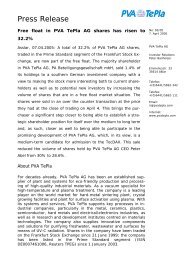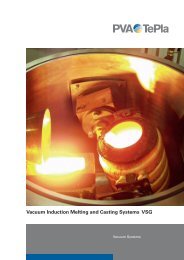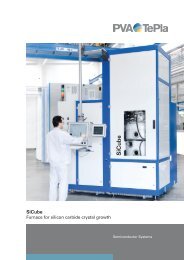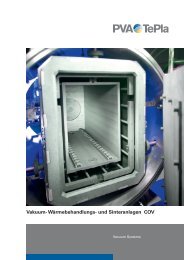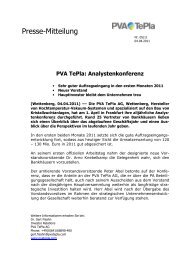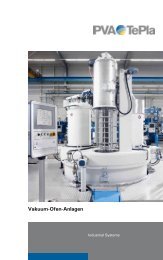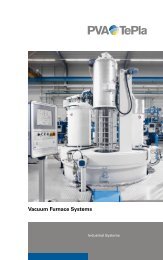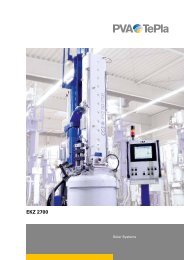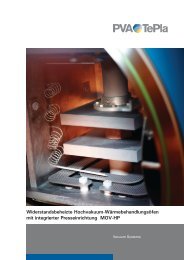Consolidated Annual Report 2012 and Single-Entity ... - PVA TePla AG
Consolidated Annual Report 2012 and Single-Entity ... - PVA TePla AG
Consolidated Annual Report 2012 and Single-Entity ... - PVA TePla AG
Create successful ePaper yourself
Turn your PDF publications into a flip-book with our unique Google optimized e-Paper software.
Centralized energy generation <strong>and</strong> fixed distribution that<br />
began with electrification around 130 years ago have become<br />
a thing of the past. The grid of the future is no longer<br />
a one-way street. The aim is to integrate <strong>and</strong> coordinate<br />
many different decentralized sources with varying outputs<br />
into a single system. The challenge is similar to that of the<br />
internet revolution, except that instead of Web 2.0, we are<br />
talking about eGrid 2.0! And with its vacuum heat treatment<br />
furnaces, <strong>PVA</strong> <strong>TePla</strong> also plays a role in this segment.<br />
These systems are used to manufacture components such<br />
as vacuum circuit breakers, which are used to disconnect<br />
or feed energy back into the grid. In flexible grids, this technology<br />
is becoming increasingly important!<br />
Vacuum Interrupters<br />
GRID STAbILITY NEEDS INTELLIGENCE<br />
Vacuum interrupters <strong>and</strong> circuit breakers are installed in<br />
grids all over the world. They ensure the stability of the grid<br />
in substations or municipal utility companies by switching<br />
on power sources during periods of peak dem<strong>and</strong> <strong>and</strong><br />
disconnecting them again in periods of low consumption.<br />
Such a system is necessary to keep grid voltage at a stable<br />
level. If more energy is fed into the grid than consumed<br />
from the grid, voltage simply keeps increasing, posing a<br />
danger to industrial <strong>and</strong> household appliances alike. Aside<br />
from switching <strong>and</strong> disconnecting fed-in power, modern<br />
circuit breakers also function as fuses in the event of short<br />
circuits or overload.<br />
The conversion of the power grid as part of the energy<br />
revolution is giving these components an ever-increasing<br />
significance. Due to the variety of energy suppliers, from<br />
solar power producers to wind park operators, grid intelligence<br />
solutions are having to become more advanced.<br />
What is known as smart grid, the energy grid of the future,<br />
is actually a highly flexible, consumption-driven distribution<br />
system that organizes <strong>and</strong> coordinates an enormous number<br />
of energy suppliers <strong>and</strong> consumers. As a result, energy<br />
feed-in must be regulated at more <strong>and</strong> more points on the<br />
grid in order to ensure that voltage remains constant.<br />
SWITCHING IN A VACUUM<br />
The principle of vacuum interrupter technology is almost<br />
100 years old. The difference between vacuum switching<br />
technology <strong>and</strong> conventional interrupter is that switching<br />
takes place in a vacuum. As the switching process takes<br />
place in a chamber that contains practically nothing, the<br />
process is extremely reliable, maintenance-free <strong>and</strong> safe.<br />
After all, when the supply is disconnected, there is no<br />
ionizable material that could trigger a spontaneous thermal<br />
arc discharge. Due to the high switching efficiency,<br />
vacuum interrupter components can be made extremely<br />
compact. There only needs to be a tiny gap between the<br />
contacts to disconnect the flow of electricity reliably. This<br />
level of efficiency remains stable over the entire lifecycle<br />
of around 30 years. By contrast, the efficiency of oil, air<br />
or sulfur hexafluoride (SF 6) interrupters is reduced every<br />
time the switching process is triggered. This is primarily<br />
due to the high voltages that occur in the interrupter’s contact<br />
areas. In the medium voltage range, this can be as<br />
high as 10,000 or even 40,000 volts. Each time the flow of<br />
electricity is interrupted at such voltages, a small percentage<br />
of the filling medium decays. This results in a loss of<br />
efficiency. That is why the vacuum interrupter is superior to<br />
filled components. However, the manufacturing of vacuum<br />
interrupters is very complex. And that’s where <strong>PVA</strong> <strong>TePla</strong><br />
comes into play.<br />
9<br />
<strong>PVA</strong> <strong>TePla</strong> in Focus




